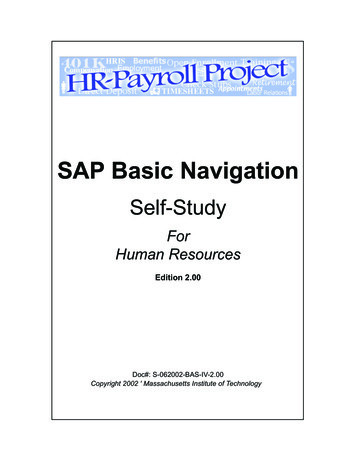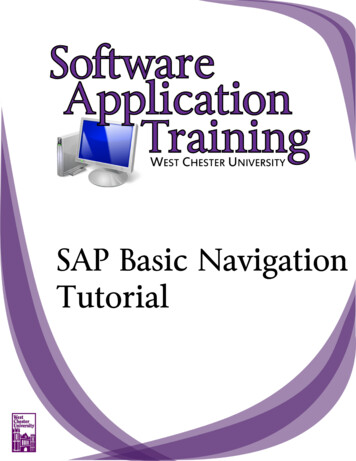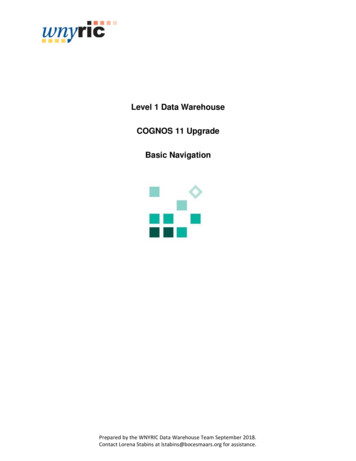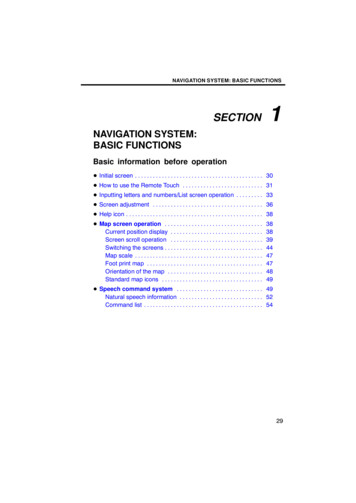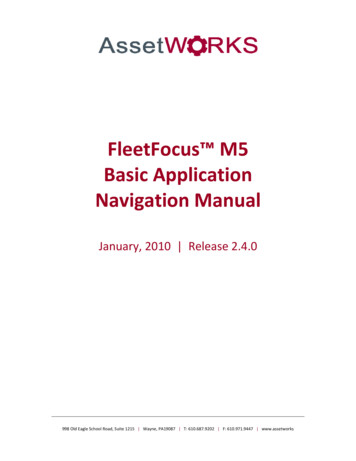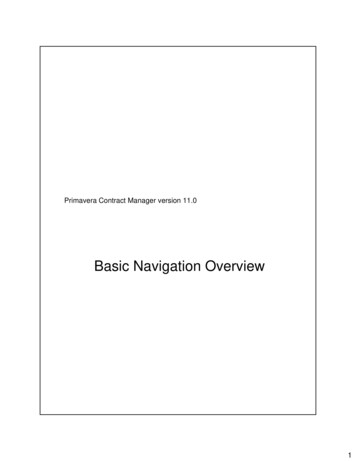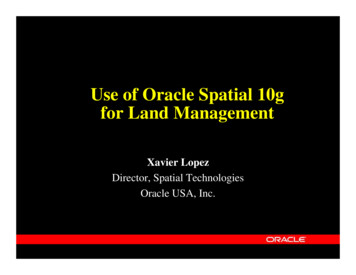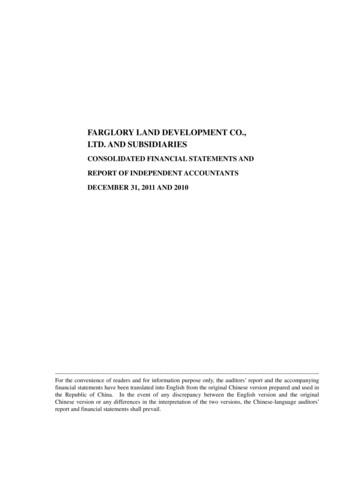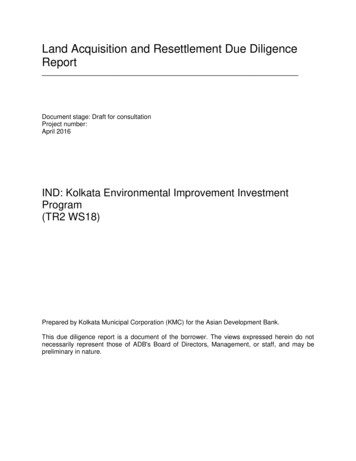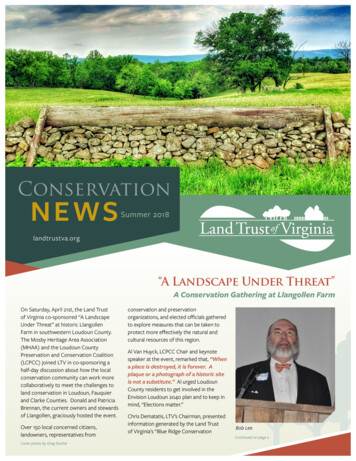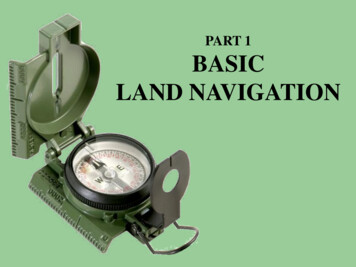
Transcription
PART 1BASICLAND NAVIGATION
PART 1 Basic Land NavigationUSING THEMILITARYLENSATICCOMPASS
PART 1 Basic Land NavigationWARNINGThis presentation is intended as aquick summary, and not acomprehensive resource. If youwant to learn Land Navigation indetail, either buy a book; or getsomeone, who has the knowledgeand skills, to teach you in person.
PART 1 Basic Land NavigationNOTETo get the ideas across presented onthese slides, many figures, pictures,and calculations may not be to scaleand may be exaggerated for clarity.
PART 1 Basic Land NavigationNote:Prior to being issued any training *equipment, you willbe required to sign a “statement of liability” agreeingto pay for anything you damage or lose.All items will be inspected and inventoried prior toyour signature and at the end of the training day too.If you do not intend to sign this statement, then youmay be denied training.* You may use your own equipment.
PART 1 Basic Land NavigationAny Questions?
PART 1 Basic Land NavigationLAND NAVIGATION WITH MAPAND LENSATIC COMPASS
PART 1 Basic Land NavigationLAND NAVIGATIONWhy Learn Land Navigation? Training and practicing land navigation on footprovides the following everyday navigation (how not to get lost) benefits;- Tracking present location (Where am I ?)- Determining Distance (How far is it and am I there yet ?)- Sense of direction (Where do I want to go and where am I actually going ?)- How to read a topographic map (Do I understand the map ?)-Terrain and map association (What hill or river am I looking at ?)- Spatial skills (Can I mentally visualize the landscape in 3D ?)- Planning safe, practical routes (Take a long safe route or a short risky route ?)- And more Navigational skillsThe best way to learn LAND NAVIGATION is to get "dirt time", that is, get out there with a map and compass!Navigation is not about finding yourself after you are lost (although that’s what happens sometimes); it’s aboutkeeping track of your position as you move away from a known point. As you move you have to remaincognizant of the terrain you are leaving, of the terrain you are passing, and of the terrain that is ahead.Navigation in the wilderness means knowing your starting point, your destination, and your route to get there.These skills will allow you to venture farther off the beaten path than you ever thought before.
PART 1 Basic Land NavigationTHIS PRESENTATION IS DIVIDED INTO FOUR PARTSPART 1Basic Land Navigation The Lensatic Compass The Topographic Map The Land and Map AssociationPART 2Intermediate Land Navigation Making Sense of Direction Tracking Present Location Determining Travel DistancePART 3Advance Land Navigation Planning to Navigate Navigation Methods to Stay On Course Additional Skills of Land NavigationPART 4Expert Land Navigation Navigation in different types of Terrain Night Navigation Sustainment
PART 1 Basic Land NavigationAny Questions?
PART 1 Basic Land NavigationPART 1BASIC LAND NAVIGATION The Lensatic Compass– Description– Parts and Features The Topographic Map– Description– How to Read The Land– Terrain Features– Terrain and Map Association
PART 1 Basic Land NavigationTHE LENSATIC COMPASSThe genuine Lensatic compass differsfrom the type most hikers are familiarwith, the traditional "orienteering"compasses. The Lensatic, a designpreferred by military forces for itsprecision and durability, is designed totake hyper-accurate bearings for landnavigation and directing artillery fire!
PART 1 Basic Land NavigationLENSATIC COMPASSDESCRIPTION Preferred by military for its precision and durability, and its hyper-accuracy in landnavigation and combat. Battle tested - shock, water, sand proof, and functional from -50ºF to 150ºF. Uses a retractable lens to read the bearing while simultaneously sighting an object. With the Lensatic you just point and shoot one target and immediately move on to the next. Luminous Lights allow for navigation in low-light conditions and night navigation. Equipped with a magnifying lens, sight wire, and dial graduations in both degrees and milsto ensure accurate readings. Copper induction dampening system slows the rotation of the magnet without the use ofliquids. Retractable lens locks the dial jewel bearing when stowed to lessen wear and tear. Employs a "Card" type compass Dial, and this makes for single handed operation.(Most magnetic "needle" type, always requires 2 hands.) A 'deep-well' design is used to allow the compass to be used globally with little or no effectin accuracy caused by a tilting compass dial. Lensatic sighting compasses are so simple and rugged and incredibly easy to use that it isno wonder they are the standard type used for navigation by the U. S. Military.
PART 1 Basic Land NavigationLENSATIC COMPASSGENUINE or IMITATIONCheap Lensatic CopiesWhen someone tried to buy a genuine CAMMENGA LENSATIC COMPASS from websites, they cameacross a whole raft of cheap imitations. Most outlets tell you they are selling ‘Military Style’ Lensaticcompasses (fake, inaccurate, missing features) – but some claim to offer U.S. Government Military Lensaticcompasses for just 14.95, which are also fake cheap imitations.Cheap copies break easily, are not accurate, have false features displayed on the compassglass face and will mislead you.The genuine lensatic compass used by the military is very durable, accurate, and easyto use. It can survive rough handling and harsh environments.Buy the Genuine ArticlePurchasing a genuineCAMMENGA LENSATICCOMPASS is easy, go towww.cammenga.comClick belowLensatic Compass Evaluation.pdfto read about the comparisonof compasses “orienteering compassvs.lensatic compass”.
PART 1 Basic Land NavigationAny Questions?
PART 1 Basic Land NavigationLENSATIC COMPASSPARTS and Features of a Lensatic compassBezelFloating DialFixed Index LineLuminous Magnetic ArrowLuminous Sighting DotsSighting Wire3. LENSREARSITESighting SlotLuminous Bezel LineLuminous HeadingLensLanyard RingThumb LoopGraduated Straight Edge1. COVER2. BASE
PART 1 Basic Land NavigationLENSATIC COMPASSCover - Protects the floating dial and other parts of the compass when closed.Sighting Wire - front sight used with rear sight, for sighting landmarks for azimuth headings.Luminous Sighting Dots – used in low-light condition and night navigation. Also a visualqueue on aligning your body with the compass during night navigation.Graduated Straight Edge - upper half of a standard 1:50,000 scale map ruler, for measuringdistances on a map.
PART 1 Basic Land NavigationLENSATIC COMPASSBase - The main body of the compass.If, for any reason, the lensatic compasswere to malfunction, the base would be the piece that you would want to still work. Bezel Ring – device clicks when turned; full 360 rotation is 120 clicks; each click equals 3 .Luminous Bezel Line – Used to mark a course direction during day or night navigation.Floating Dial – black scale (mils), red scale (degrees), set in a deep tub for global use.Luminous Heading – to read azimuth heading in low-light or night conditions.Luminous Magnetic Arrow – always points to magnetic north.Thumb Loop – to hold compass with the thumb.Fixed Index Line – azimuth heading.Lanyard Ring – for string or rope.NOTE:The only way for the compassto malfunction is for the user tomisuse and abuse the compass.
PART 1 Basic Land NavigationFLOATING DIAL SCALEBLACK RINGMils - is used mainly in artillery, tank, andmortar gunnery. AND is also used for veryaccurate azimuth land navigation. 6400 Mils to a Circle Distance Between Small Marks 20 Mils Distance Between Big Marks 100 Mils Distance Between Numbers 200 MilsN 64 (6400)E 16 (1600)S 32 (3200)W 48 (4800)8.89 Mils ½ Degree17.78 Mils 1 DegreeLENSATICCOMPASS
PART 1 Basic Land NavigationFLOATING DIAL SCALEBLACK RINGMils - is used mainly in artillery, tank, andmortar gunnery. AND is also used for veryaccurate azimuth land navigation. 6400 Mils to a Circle Distance Between Small Marks 20 Mils Distance Between Big Marks 100 Mils Distance Between Numbers 200 MilsN 64 (6400)E 16 (1600)S 32 (3200)W 48 (4800)8.89 Mils ½ Degree17.78 Mils 1 DegreeRED RINGDegrees – common unit of measure isthe degree (º). 360 Degrees to a Circle Distance Between Red Marks 5º Distance Between Big Marks 10º Distance Between Red Numbers 20ºN 0ºE 90ºS 180ºW 270º
PART 1 Basic Land NavigationAny Questions?
PART 1 Basic Land NavigationLENSATIC COMPASSGRADUATED STRAIGHT EDGEApproximately 1 inch (every 13 ticks)Exactly 1 cm (every 5 ticks)Used to take distance measurements from point ―A‖ to point ―B‖on maps; in conjunction with the distance bar scales on the map.NOTEWhen used on a 1:50,000 map, each tick mark on the edgerepresents 100 meters (107 yards) of ground distance.ZERO
PART 1 Basic Land NavigationLENSATIC COMPASSLens Rear Site - Sighting device. Lens - used to read the dial.Rear Site - used in conjunction with the front site wire for sighting on objects.NOTE:The Lens Rear Sight also serves as a locking deviceand locks the dial jewel bearing to protect from wearand tear when closed. Also the rear sight must beopened more than 45 to allow dial to float freely.When traveling make sure that the rear sight istotally folded down as this will lock the floatingdial and prevent vibration, as well as protect thecrystal and rear sight from being damaged.
PART 1 Basic Land NavigationAny Questions?
PART 1 Basic Land NavigationLENSATIC COMPASSHANDLING A COMPASSWhen buying a new compass check . . . That the dial does not stick Sighting wire is not bent Glass and other parts are not broken Numbers on the dial are legible Check for accuracy along a known line of direction— Discard any type of compass with more than a 3 /- variation.— Lensatic compass is accurate to a ½ degree (better when using the mils scale). When traveling make sure that the rear sight is totally folded down as this will lock the floatingdial and prevent vibration, as well as protect the crystal and rear sight from being damaged.EFFECTS OF METAL AND ELECTRICITY – these sources affect the performance of a compass during use. 180 feet / 55 metersHigh tension power lines 33 feet / 10 metersTruck, car, Barbed wires 6 feet / 2 meterHunting rifle 1 feet / ½ meterKnife, flashlight, binoculars, camera Inches / centimetersBelt buckle, paper clip, jewelry, etc. Misc distancesany local geological magnetic rocks.
PART 1 Basic Land NavigationLENSATIC COMPASSINSPECTING A COMPASSCompasses are delicate instruments and should be cared for accordingly. A detailedinspection is required when first obtaining and using a compass. Important serviceabilitychecks are outlined below:VISUAL INSPECTION Your compass should be opened to see that the cover glass is not broken, clouded, orcracked and that the compass dial does not stick. The front cover should be inspected to see if the cover sighting wire is missing orbent. If it is, use the center of the opening for sighting purposes, not the wire. The eyepiece should be placed flat against the cover glass. The index line on the cover glass should bisect the sight slot.Then, with the compass closed, it should be noted that the sighting wire also bisects the sight slot. This procedure will ensure that the eyepiece is not bent. Gently bend the eyepiece back into proper alignment, ifnecessary. Check the bezel ring around the face of the compass; it should make a distinct click as it is rotated. If it does not click,you will have to use an alternate method for night azimuth settings.MAINTENANCE The lensatic compass is built to detailed specifications that were developed in an attempt to increase its serviceable life.Adherence to very simple maintenance procedures will significantly increase the life of the lensatic compass. Maintenanceprocedures are outlined below: Rinse in fresh water. This is extremely important, especially after exposure to salt water. Brush off dirt and grime. Ensure the "ridges" on the bezel ring are free of dirt. Check movement of the rear sight toensure it is free moving.
PART 1 Basic Land NavigationLENSATIC COMPASSCALIBRATIONA compass in good working condition is very accurate, but it should be checked periodicallyon a known line of direction. This process is called compass calibration.CALIBRATION Note the calibration point azimuth. This is the known magnetic azimuthfrom the calibration point to a designated point. Shoot an azimuth from the calibration point to the designated pointutilizing the compass-to-cheek technique (described in detail later in thishandout). Ensure you check for effects on your compass from your eyeglasses,watches, rings, etc. If you wear these items in the field, ensure you wearthem when calibrating your compass.Compare azimuths: If your compass shot an azimuth greater than the calibration point azimuth, then you must add thedifference between the two azimuths (the calibration point value) to your computed magnetic azimuth. Conversely, you must also ensure you subtract this value when converting from an actual compass(magnetic) azimuth to a grid azimuth. If your compass shot an azimuth less than the calibration point azimuth, then you must subtract thedifference between the two azimuths (the calibration point value) from your computed magnetic azimuth. Conversely, you must also ensure you add this value when converting from an actual compass(magnetic) azimuth to a grid azimuth.
PART 1 Basic Land NavigationAny Questions?
PART 1 Basic Land NavigationHOW TO SIGHTALENSATIC COMPASS
PART 1 Basic Land NavigationSIGHTING A LENSATIC COMPASSCompass-to-Cheek methodfor taking a target azimuth bearing The compass-to-cheek technique is used almost exclusively for sighting, and it is the besttechnique for this purpose.It is the most efficient technique for taking an accurate azimuth bearing.
PART 1 Basic Land NavigationSIGHTING A LENSATIC COMPASS
PART 1 Basic Land NavigationSIGHTING ALENSATICCOMPASS
PART 1 Basic Land NavigationSIGHTING A LENSATIC COMPASS
PART 1 Basic Land NavigationAny Questions?
SIGHTING A LENSATIC COMPASSPART 1 Basic Land Navigation
SIGHTING A LENSATIC COMPASSPART 1 Basic Land Navigation65 AZIMUTH(11.5m 1,150mils)
PART 1 Basic Land NavigationSIGHTING A LENSATIC COMPASSCompass-to-Cheek methodfor taking a target azimuth bearingthis is worth repeating The compass-to-cheek technique is used almost exclusively for sighting, and it is the besttechnique for this purpose.It is the most efficient technique for taking an accurate azimuth bearing.
PART 1 Basic Land NavigationSIGHTINGLENSATICCOMPASSRIGHT
PART 1 Basic Land NavigationSIGHTINGLENSATICCOMPASSRIGHT
PART 1Basic Land NavigationSIGHTINGLENSATICCOMPASSWRONG
PART 1Basic Land NavigationSIGHTINGLENSATICCOMPASSRIGHT
PART 1Basic Land NavigationSIGHTINGLENSATICCOMPASSRIGHT
PART 1Basic Land NavigationSIGHTINGLENSATICCOMPASSRIGHT
PART 1 Basic Land NavigationSIGHTINGLENSATICCOMPASSWRONG
PART 1 Basic Land NavigationSIGHTINGLENSATICCOMPASSRIGHT
PART 1 Basic Land NavigationSIGHTINGLENSATICCOMPASSWRONG
PART 1 Basic Land NavigationSIGHTINGLENSATICCOMPASSWRONG
PART 1 Basic Land NavigationAny Questions?
PART 1 Basic Land NavigationLENSATIC COMPASSCenter-Hold methodfor taking a target azimuth bearingThe center-hold technique is less precise, but is faster to use and can be used under all conditions of visibility.1.Open the cover until it forms a straight edge with the base.2.Pull the rear sight to the rear most position, allowing the dial to float freely.3.Next, place your thumb through the thumb loop, form a steady base with your third and fourth fingers, andextend your index finger along the side of the compass.4.Place the thumb of the other hand between the rear sight and the bezel ring; extend the index fingeralong the remaining side of the compass, and the remaining fingers around the fingers of the other hand.5.Pull your elbows firmly into your sides; this will place the compass between your chin and your belt.6.To measure azimuth, turn entire body toward the object, pointing the compass cover directly at the object.7.Once you are pointing at the object, look down and read the azimuth from the fixed black index line.
PART 1 Basic Land NavigationLENSATIC COMPASSCenter-Hold method for following an azimuth bearing1.Using the Center-Hold method to hold the compass to your body.2.Turn your body till desired azimuth is aligned with Black Index Line, hold this azimuth. Example 25º.3.Without turning compass, rotate Bezel Ring till Luminous Bezel Line is aligned with North Arrow .4.Once bezel is set leave it there. (Till you are ready to change heading, then start the process over again.)5.Keeping the North Arrow aligned with the Luminous Bezel Line, proceed forward in the directionof the desired azimuth 25º on the Black Index Line.STEP 2STEP 3
PART 1 Basic Land NavigationAny Questions?
PART 1 Basic Land NavigationTHE TOPOGRAPHIC MAPWithout ever having beento a particular place, and with outtalking to someone who has beenthere, you can already know quitea lot about it with a map. A map isa graphic representation of theearth’s surface drawn to scale, asseen from above. It uses colors,lines, symbols, and labels torepresent features found on theground.However, the finest mapsavailable are worthless unless themap user knows how to read them.
PART 1 Basic Land NavigationTOPOGRAPHIC MAPDESCRIPTION Reading a map is a language composed of lines, colors, and symbols. Five basic colors are used for Topographic Maps.– Brown (Contour Lines)– Black (Man Made Features, Roads, Trails)– Blue (Water Features)– Green (Vegetation)– Red (Highway and Land Grids)– Two minor colors Pink (Built up area, civilization)Purple (Updated Map Information) Symbols are used to represent the natural and man-made features of the earth. Lines show relief and elevation; it indicates variations in terrain features and heights of natural features. Every map has Margin Information about the map. Maps come in three scale sizes; SMALL, MEDIUM, and LARGE. Which affects the amount of areacovered and detail that will be shown. A map is read for four basic kinds of information.– Direction– Distance– Position– Identification Maps must be taken care of and properly folded for field use.
PART 1 Basic Land NavigationMap Margin Information A map could be compared to any piece of equipment, in that before it is placed into operation the usermust read the instructions. It is important that you know how to read these instructions. The most logical place to begin is the marginal information and symbols, where useful information tellingabout the map is located and explained. All maps are not the same, so it becomes necessary every time a different map is used to examine themarginal information carefully.
PART 1 Basic Land NavigationMap Margin InformationThe top left corner of all USGS topographic maps carries the imprint of the authorityresponsible for the mapping .
PART 1 Basic Land NavigationMap Margin InformationIn the upper right corner is the complete quadrangle name. The state is also given,as may be the county. Also included is the area covered and the type of map.
PART 1 Basic Land NavigationMap Margin InformationIn the bottom right corner of the map is a key to roads on the map. Map name and state.date of the map - one of the most significant pieces of information available.quadrangle location shown as a black square superimposed on a state map.
PART 1 Basic Land NavigationMap Margin InformationAt bottom center is the map scale ratio – size of area covered and terrain detail.Distance bar scales show several alternative units for the measurement of distance.the contour interval. The contours are the brown lines.
PART 1 Basic Land NavigationMap Margin InformationIn the lower left corner
LENSATIC COMPASS DESCRIPTION Preferred by military for its precision and durability, and its hyper-accuracy in land navigation and combat. Battle tested - shock

